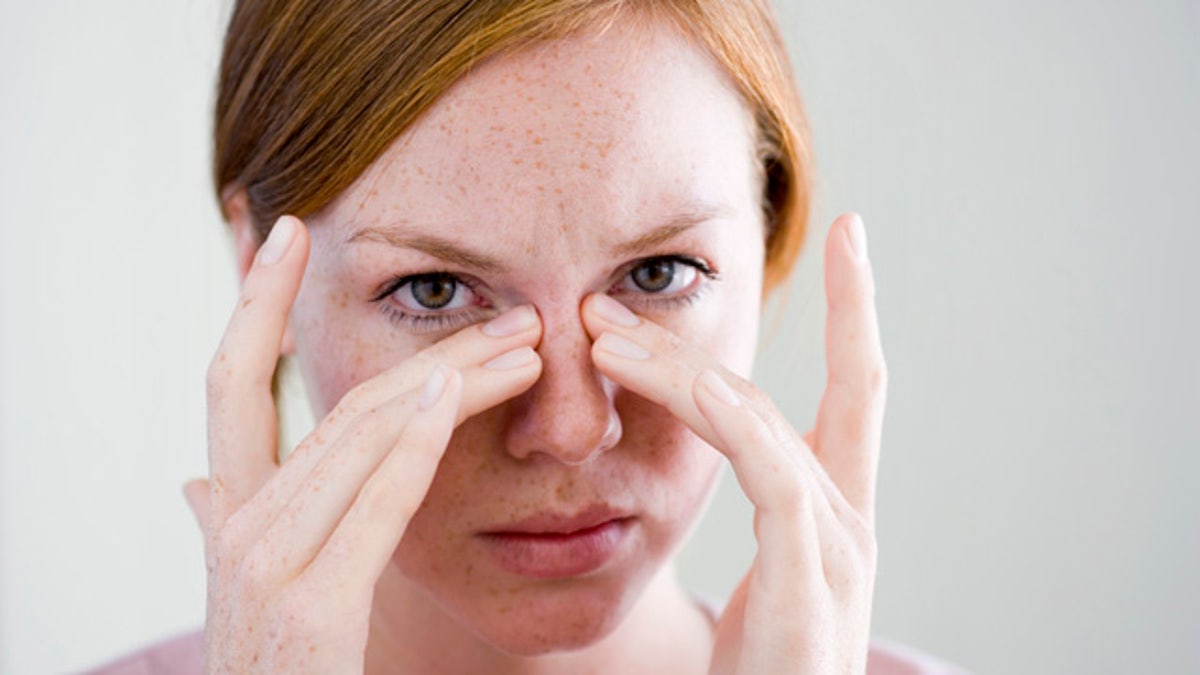
Woman with fingers on nose ((C) 2007 Pixland)
Pollen season is a distant memory, you’ve long since shut car windows in favor of cranking the heat, and you haven’t seen an allergy commercial in what, four months?
But if your nose is perpetually stuffy, your eyes itchy, and your head feels like it’s about to explode—you might just have winter allergies. Largely synonymous with indoor allergies, their symptoms tend to peak in the winter months but people often confuse their symptoms with that of a cold because they don’t have any problem with indoor allergens during the summer months, explains Neeta Ogden, M.D., a New Jersey allergist and spokesperson for the American College of Allergy, Asthma and Immunology.
RELATED: The 14 Healthiest Snack Foods to Buy
However, during the winter, you’re exposed to way more indoor allergens like mold, dust mites, and animal dander than you are in the summer. After all, during the year’s coldest months, we spend pretty much all of our waking hours locked up with them, she says.
Luckily, avoiding winter allergies doesn’t have to mean getting outside and braving the cold. Here are seven easy ways to fight winter allergens from the comfort of your warm and cozy couch.
RELATED: 7 New Moves for Perfect Abs
Boost Your Bedroom Hygiene
The bedroom is the number-one hiding spot for dust mites, says allergist and immunologist Clifford Bassett, M.D., medical director of Allergy and Asthma Care of New York. So if you typically wake up feeling stuffy, your bedding is probably an issue. Buy covers for your pillows and mattress (look for ones that say they are “impervious” to dust mites or allergens). Once you put them on, nothing is getting in or out. Wash the covers a couple of times a year, and your sheets every week, recommends Ogden. Run both your washer and dryer on “hot” to help kill anything lurking in your bedding.
RELATED: The Fastest Ways to Get Ripped
Filter Things Out
By capturing allergens floating through your house’s air, high-efficiency particulate air (HEPA) filters can drastically improve symptoms in winter allergy sufferers. Most are pretty small and can be set up in the corner of your bedroom or living room to help you breathe easy, Bassett says. If you own your home, you can also reach out to the manufacturers of your HVAC to see if your heating and cooling system can be outfitted with HEPA filters.
RELATED: Shirtless Nick Jonas Explains How He Got His New Buff Body
Hit the Right Moisture Balance
Breathing dry indoor air can make allergies so much worse. It dries out your nasal passages, irritating and inflaming them so that the slightest whiff of an allergen sends you reeling, Bassett says. Unfortunately, humidifying your air to no end can lead to mold growths and allergies. To find a happy medium, he recommends using a humidifier—and a hygrometer, which measures the moisture levels in the air. Shoot for indoor air humidity levels of 35 to 45 percent.
Have Someone Else Groom Your Dog
Frequently bathing and brushing your dog can keep dander at bay—especially when he’s spending extra time inside, too, Ogden says. But if you attempt the grooming yourself, you could end up having allergy flare-ups on every bath day. Invest in finding Fido a groomer for regular spa days.
RELATED: 8 Ways to Boost Your Metabolism
Use a Saline Spray
Apart from moisturizing your nasal passages, a couple squirts of a saline spray before bed can help get any gunk (including allergens) that are trapped in your nose, Ogden says. That way, you won’t be stuck breathing them in for the eight hours you’re asleep and you’ll wake up feeling much clearer.
Vacuum More
OK, ideally, you’d get rid of that carpeting in your house, but barring a renovation, you can stand to vacuum more, Ogden says. It will help suck up the pet dancer and human skin cells that attract and feed dust mites. Use a HEPA-equipped vacuum to sweep at least once per week.
RELATED: Brad Pitt Is Back and Sexier Than Ever
Call an Exterminator
As if cockroaches weren’t gross enough on their own, it turns out they can contribute to asthmatic symptoms, especially in allergy sufferers, Bassett says. And one Environmental Health Perspectives study of 831 houses found that two-thirds them contained detectable levels of cockroach allergens, with apartments and older, urban homes sporting even higher levels.
